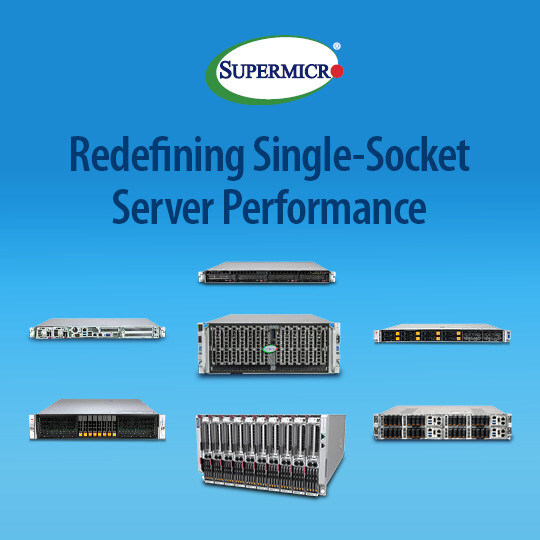Supermicro Unleashes 20+ Next-Gen Systems, Redefining Single-Socket Performance & Data Center Efficiency
New system architectures support Intel® Xeon® 6 with P-Cores, providing up to 136 PCIe 5.0 lanes and expanding possibilities for high-speed networking, GPUs, and storage devices
SAN JOSE, Calif., March 28, 2025 /PRNewswire/ -- Super Micro Computer, Inc. (SMCI), a Total IT Solution Provider for AI/ML, HPC, Cloud, Storage, and 5G/Edge, is announcing the availability of new single-socket servers capable of supporting applications that required dual-socket servers for a range of data center workloads. By leveraging a single-socket architecture, enterprises and data center operators can reduce initial acquisition costs, ongoing operational costs such as power and cooling, and reduce the physical footprint of server racks compared to previous generations of systems based on older processors.

Single Socket Performance Models
"We are entering a new era of compute where energy-efficient and thermally optimized single-socket architectures are becoming a viable alternative to traditional dual-processor servers," said Charles Liang, president and CEO of Supermicro. "Our new single-socket servers support 100% more cores per system than previous generations and have been designed to maximize acceleration, networking, and storage flexibility. Supporting up to 500-watt TDP processors, these new systems can be configured to fulfill a wide range of workload requirements."
For more information, please visit http://www.supermicro.com/singlesocket
"We are excited to continue our long-standing collaboration with Supermicro to deliver high-performance server solutions," said Karin Eibschitz Segal, corporate vice president & interim GM, Intel Data Center & AI Group. "Our expanded portfolio of single-socket systems, optimized with the latest Intel Xeon 6 processors with P-cores, offers increased core counts, faster memory support, and up to 136 PCIe 5.0 lanes—delivering performance previously only achievable with dual-socket platforms."
"As businesses continue to prioritize efficiency, flexibility, and cost effectiveness for their infrastructure, single-socket servers are emerging as a compelling solution," said Kuba Stolarski, research vice president for IDC's Computing Systems practice. "These single-socket servers provide an optimal balance of performance, scalability, and total cost of ownership needed for a wide range of workloads, from edge computing to virtualization, making them an ideal choice for companies looking to scale efficiently in an evolving market."
Supermicro's single-socket server systems can be configured to handle a variety of workloads, including EDA, FSI, cloud computing, storage, content delivery, virtualization, AI, networking, and edge computing. Deploying a single-socket architecture has several key advantages over multi-processor systems, including, the absence of the CPU-CPU interconnect, which frees up more of the processor's I/O capacity for PCIe expansion and avoids latency issues related to Non-Uniform Memory Access (NUMA). The enhanced PCIe lane availability compared to previous generations means more and faster networking, storage, and acceleration devices can be added to each system, increasing overall system compute capacity and rack density.
Customers can expect significant benefits when deploying single-processor servers to run their applications. For many cloud and storage-centric workloads, performance that previously required two CPUs per system can be achieved or even exceeded with a single processor. By deploying single-socket servers, customers can realize cost savings not only on the initial acquisition of the servers, but also due to reduced power consumption, lower thermal load reducing cooling requirements, and the need for less physical space to house the data center infrastructure.
Supermicro product families optimized for single-socket Intel Xeon 6 processors with P-Cores:
- SuperBlade® – Is a flagship green computing solution with maximum performance, higher availability, and lower TCO for stock and option exchanges, AI Inferencing, EDA, Data Analytics, HPC, Cloud, and Enterprise workloads. SuperBlade systems are available in either air-cooled or liquid-cooled configurations. Overall, there are up to 20 servers in an 8U enclosure or 10 servers in a 6U enclosure. In addition, there are up to four double-wide and single-wide GPUs or PCIe cards available per server, and efficient system design can significantly reduce cabling requirements.
- Hyper – Flagship performance rackmount servers designed for scale-out cloud workloads, with storage & I/O flexibility that provides a custom fit for a wide range of application needs. Optimized for AI inferencing, these Hyper systems can support a variety of GPUs.
- CloudDC – This is an all-in-one platform for cloud data centers, based on the OCP Data Center Modular Hardware System (DC-MHS) with flexible I/O and storage configurations along with an AIOM slot (PCIe 5.0; OCP 3.0 compliant) for maximum data throughput.
- WIO – Offers flexible I/O configurations in a cost-effective architecture to enable optimization of acceleration, storage, and networking alternatives to accelerate performance, increase efficiency and find the perfect fit for specific enterprise applications. WIO systems come with SATA controller and dual 1G ports onboard to provide additional value to customers.
- Top-loading Storage – Density-maximized storage systems optimized for software-defined data centers, with easy-to-deploy 60 or 90 drive bays.
- GrandTwin® – Purpose-built for single-processor performance and memory density, featuring front (cold aisle) hot-swappable nodes and front or rear I/O for easier serviceability. Now available with E1.S drives for better storage density and throughput.
- Edge – High-density processing power in compact form factors optimized for Edge data center installation.
What the stars mean:
★ Poor ★ ★ Promising ★★★ Good ★★★★ Very good ★★★★★ Exceptional

 Tag:
Tag:
















 Mobile Version
Mobile Version